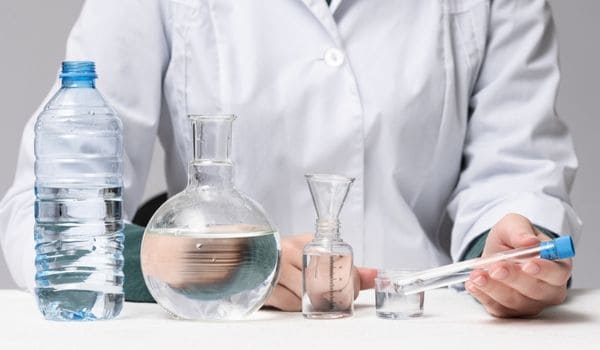If your well water leaves rust stains in the sink or smells a little off, iron could be the culprit. And while it’s not dangerous to drink, it’s a serious nuisance—staining everything from your laundry to your appliances, and even messing with water pressure.
The tricky part? Iron doesn’t always show up the same way. Some forms are invisible until they oxidize. Others cling to bacteria and create slimy buildup in your pipes. That’s why a one-size-fits-all filter usually falls short.
So let us walk you through how to fix iron problems in your well water — it all starts with a water test and the right setup — let’s go..
🧠 Quick Takeaways
- ✅ Iron in Well Water Comes in Many Forms – Including clear ferrous iron, rusty ferric iron, and bacterial iron that creates orange slime
- 🔬 Testing is Step One — You’ll need to know your iron levels and pH before choosing a filter — lab-grade water tests give you the full picture
- 🚿 Some Filters Work Better Than Others – Oxidation systems and dedicated iron filters are usually more effective than basic softeners or sediment filters
- 🧪 pH Matters More Than You Think – Acidic water can reduce your filter’s effectiveness — you may need a pH booster to get the best results
- 🧰 Maintenance Isn’t Optional – Even the best systems need backwashing, media replacement, or chemical dosing to keep working right
💢 Why Iron Shows Up in Wells

Iron in your well water isn’t just annoying—it’s a sign that something upstream isn’t quite right. Whether it’s natural, chemical, or biological, understanding where that iron comes from is key to getting rid of it. 👇
- Natural Sources: Iron is everywhere in rocks and soil. As groundwater flows through, it picks up dissolved iron.
- Corroded Plumbing: If your well uses steel or iron parts, corrosion over time can leach iron into the water supply.
- Runoff from Nearby Activity: Industrial work, farming, or mining near your property can contribute to iron levels through runoff and leaching.
🧪 The 3 Types of Iron You Might Be Dealing With
| Type | Description | Common Signs |
|---|---|---|
| 🧪 Ferrous (Fe²⁺) | Dissolved, clear in water | Turns reddish-brown when exposed to air |
| 🛁 Ferric (Fe³⁺) | Oxidized, visible rust particles | Orange stains on fixtures and laundry |
| 🦠 Bacterial Iron | Iron-loving bacteria form sticky sludge | Slimy orange buildup, musty smell |
🏠 Why It’s a Problem for Your Home
- Staining: Rust-colored streaks on sinks, tubs, and toilets
- Bad Taste: Metallic or earthy flavor in your drinking water
- Clogs & Corrosion: Iron buildup in pipes and appliances shortens their lifespan
💡 Pro Tip: If you’ve got rust stains and your water tastes metallic, chances are you’re dealing with more than one type of iron.
👉 A lab test can reveal whether it’s ferrous, ferric, or bacterial, so you don’t waste money on the wrong filter.
🚿 How to Get Cleaner, Iron-Free Water

There’s no one-size-fits-all filter for iron. What works depends on the type of iron in your water, how much of it there is, and what else is going on in your plumbing.
So before dropping hundreds on a system, let’s lay out your main options side by side.
🔍 Quick Look: Ways to Treat Iron Issues
| 🔧 Method | 🎯 Best For | ⚠️ Considerations |
|---|---|---|
| 💨 Oxidation Filters | High iron levels, both ferrous & ferric | Requires backwashing; may need pH adjustment |
| 🌬️ Aeration Systems | Moderate iron and hydrogen sulfide | Needs space and regular maintenance |
| 🧪 Chemical Injection | Very high iron or bacterial contamination | Requires chemical handling and monitoring |
| 🍃 Greensand Filters | Iron + manganese or sulfur odors | Needs potassium permanganate to regenerate |
| 🚰 Reverse Osmosis | Small-scale drinking water iron removal | Not ideal for whole-house use |
| 🧂 Water Softeners | Low iron + hard water treatment | Limited iron capacity; not for ferric iron |
🛠️ Choosing the Right Setup
Not every system is built for every iron problem. Some filters work great for rust stains, others for slime or taste issues—but it all hinges on your water chemistry.
👉 That’s why we always recommend starting with a proper iron water test before making a move.
Once you know what you’re dealing with, you’ll have a much easier time picking the right setup—and skipping the trial and error.
👷 When to Call in a Pro

Some setups are simple. Others? Not so much. If your iron levels are high, or you’re installing a more advanced system like a chemical injector or backwashing filter, professional help might save you time (and a plumbing headache).
Here’s a quick breakdown of what pros bring to the table:
| 🔩 Service | 💡 Why It Matters |
|---|---|
| 📐 System Sizing | Ensures the filter is rated for your water chemistry and flow rate |
| 🔧 Installation | Proper pipe layout, bypass valves, and drainage for long-term reliability |
| 🧪 Water Retesting | Verifies your system is removing iron as expected |
| 📅 Maintenance Scheduling | Prolongs system life and prevents sudden performance drops |
While DIY installs can work for basic systems, getting help from a pro means fewer surprises—especially if you’re dealing with high iron, sulfur, or complex plumbing. Bonus: they’ll often spot future issues you didn’t know to look for.
🧪 Testing Your Water the Right Way

Not all iron makes itself obvious. Some types stay dissolved and invisible, while others only show up after they oxidize. If you’re just guessing based on stains or smell, you might end up with the wrong filter.
Here’s how to test for iron the right way:
| 🔍 Method | 🧠 What It Tells You |
|---|---|
| 👁️ Visual Clues | Red or orange stains? That’s likely ferric iron. Slimy buildup? You might have bacterial iron. |
| 🧪 At-Home Test Kits | Can detect total iron, but often miss things like pH, manganese, or bacterial iron |
| 🧫 Lab Testing | Gives a full picture: iron levels, pH, hardness, dissolved oxygen, tannins & more |
Pro Tip: If you’re seeing rust stains and dealing with odd smells or slime, it’s probably more than one type of iron. A full test lets you target the root problem instead of just treating symptoms.
⚖️ Why pH Can Make or Break Your Filter

Even the best iron filter needs the right conditions to work properly — and pH is a big one. If your well water is too acidic (below 7), it can reduce the effectiveness of iron removal systems or even damage the filter media.
| 📊 pH Range | 🔧 Impact on Iron Filters |
|---|---|
| ⬇️ Below 7 (Acidic) | Can prevent oxidation and reduce filtration efficiency; may corrode plumbing |
| ✅ 7–8.5 (Neutral to Alkaline) | Ideal for most iron filters — promotes effective oxidation and longer media life |
| ⬆️ Above 8.5 | Uncommon in wells, but may require adjusted filtration media for full performance |
Good to Know: If your pH is too low, don’t panic. An alkalizing prefilter (like calcite or soda ash) can raise it into the sweet spot — giving your iron filter a better shot at doing its job right.
🧼 Final Thoughts
Iron may be a powerhouse in industry, but in your well water, it’s nothing but trouble. The key to getting rid of it? Start with a proper water test, then match the right filter to the type and amount of iron you’re dealing with.
And if you’re ready to stop guessing, we’ve reviewed the top-performing iron filters for well water — systems that actually work, based on real-world results.
Because nobody needs orange stains in their toilet—or mystery sludge in their pipes.
 143 people found this helpful. Was this guide helpful to you?
143 people found this helpful. Was this guide helpful to you? 

